Protection protocol: nurturing a dam and pups in a shelter maternity unit
Michelle Tobin BSc RVN outlines a protocol for the protection and nurturing of a dam and her puppies in a biosecure shelter maternity unit
This evidence-based protocol prioritises the protection and nurturing of the dam and her puppies in a biosecure shelter maternity unit. Dams require a safe, clean environment to nurse their puppies. Prolonged stress on the dam can result in physiological and psychological consequences for her puppies (Hennessy, et al., 2020), which may manifest as behavioural problems in adulthood (Guardini, et al., 2016).
Crucial time
The first three weeks after parturition is a crucial time for the dam to bond with and nurse her puppies (Lezama-García, et al., 2019). However, unmanaged stress can interfere with the production of oxytocin: a crucial hormone for anxiety reduction, milk production and dam-puppy bonding (Ogi, et al., 2020).
The shelter can be a very stressful environment for all animals, but particularly for lactating dams and their puppies. The ability to carry out normal maternal behaviour is legislated under section 11(1) of the Animal Health and Welfare Act 2013 (Irish Statute Book, 2013) and is one of the ‘Five Freedoms’ of animal welfare (ISPCA, 2020).
The shelter maternity unit should follow the same specifications of an isolation area (Boyden & Morrow, 2018). Lactating animals and juveniles under four months of age are considered high-risk groups in the shelter setting due to their immunological vulnerability and consequential susceptibility to disease (Newbury & Miller, 2018). Prior to admission to the maternity unit, a full clinical examination of the dam and puppies should be carried out to identify any disease. Following this, prophylactic health treatment (HPRA, 2020) should be carried out under the shelter vaccination and parasite control protocol (Newbury & Miller, 2018).
At high risk
Neonates have some immune system protection through maternally derived antibodies (MDAs) for a few weeks and will not be able to receive vaccination until at least six weeks of age (Nobivac, 2020). Puppies are at high risk during the time between the decline in MDAs and their first vaccine. Also, in some instances, the dam might not be healthy enough to vaccinate immediately, therefore, separation from the general shelter population as well as scrupulous cleaning and disinfection is needed to ensure that both dam and puppies are protected during this critical period (Newbury & Miller, 2018), (Morley, et al., 2005).
The key purpose of the maternity unit is to provide a safe, comfortable, biosecure environment that facilitates nursing and/or weaning until either the dam and puppies can be fostered (Gunter, et al., 2019), or until the puppies are weaned and ready for adoption.
Emergency fostering is recommended if the dam is displaying any concerning behaviours that may interfere with the maternal bond. Stress reduction techniques including positive human interaction and environmental enrichment can also help support the dam (Amaya, et al., 2020). Happy, healthy puppies and dam will be able to be re-homed quickly and will also reflect well on the shelter (Hennessy, et al., 2020).
This protocol is also adapted to reflect current hand hygiene and two-metre social distancing guidelines during the global Covid-19 pandemic (Gov.ie, 2020), (HSE, 2020) as health and safety of staff is critical to the efficient running of the animal shelter.
Maternity Unit Protocol
Staff
- Designated staff only to enter maternity unit (ie. veterinary nurse, veterinary practitioner, senior management). Key card required to access unit.
- Maternity is to be treated like an isolation facility and strict adherence to biosecurity measures and protocols is essential to the health and welfare of the animals in the unit.
Entering the maternity unit
- Enter maternity unit through entrance A (see Figure 1).
- Ensure no debris on shoes prior to walking through the hydrogen peroxide footbath. Step into footbath with both feet, immerse the soles of the shoes, and rub shoes vigorously on the mat before walking through the preparation room. This is to prevent the introduction of pathogens from the general shelter into the biosecure maternity unit.
- Check cleaning protocol on wall – it is essential to replace footbaths daily or as soon as contaminated (Figure 4).
- Follow an anti-clockwise direction around the preparation room to limit close contact with other staff who may also be in the maternity unit – in line with Covid-19 guidelines and the recommended two metres distance from others.
Hand hygiene
- At the preparation area, wash hands using the HSE-recommended handwashing technique (position pictorial guide above station) with skin scrub provided and use 70 per cent alcohol hand gel (see Figure 4).
Preparation
- Get everything ready before entering the maternity kennels:
- disposable toys;
- bowls;
- food and water;
- all cleaning equipment: detergent, disinfectant, sprayer; and,
- medications.
- Barrier nursing technique to maintain biosecurity and prevent potential disease spread. From the designated PPE storage unit, wear the following:
- disposable gloves;
- apron;
- shoe covers; and,
- eye goggles and mask when cleaning to avoid bleach fumes.
Entering the maternity kennels
- Enter the biosecure maternity kennels and check charts on dam and puppies (see Figure 2).
- Double check dam vaccination and anthelmintic treatments are up to date (see Figure 3).
- Perform subjective observation ie. distance exam on the dam and puppies prior to entering the unit, and observe dam and puppies’ behaviours and interactions with one another.
Cleaning and disinfecting
- Clean: remove all physical waste from unit such as urine, faeces, disposable bedding, and toys. Apply soap detergent to visibly clean floor, scrub, and rinse.
- Disinfect: liberally apply five per cent bleach solution to the floors and walls (see Figure 4). Leave for a contact time of 10 minutes, wipe away and allow to dry. Section the dam and puppies off into the bedding area when cleaning and disinfecting exercise area and vice versa.
- Ensure adequate ventilation to dissipate fumes created by the bleach.
Housekeeping
- Use plenty of newspaper to make warm, comfortable bedding for dam and puppies.
- Ensure heat lamp is working correctly.
- Identify and eliminate any sources of stress or anxiety for the dam such as soiled bedding or a cold or noisy environment.
Dam and puppy checks
- Administer anthelminthic treatments to dam and puppies if indicated on charts.
- Inspect and perform clinical exam on the dam and each puppy to check for anything of concern, weigh on puppy scales in the unit (see Figure 5).
- Provide a nutrient-dense diet for the dam to provide her with extra calories she requires during nursing eg. Royal Canin Mother & Babydog food or simply an extra portion of calorie-rich puppy food.
- Make sure dam has plenty of fresh water available as fluid intake will be higher when she is nursing.
- Interact with dam and give lots of positive attention and human interaction including stroking, brushing, treats and playing.
- Ensure dam gets plenty of exercise in the adjacent enclosed outdoor yard.
- Take the time to observe dam and puppies’ interactions with one another.
- Monitor dam interactions/behaviours with both puppies and staff. Record all interactions on chart.
- Replace disposable toys and bedding where necessary, using only colour-coded items within the maternity unit. Make a note on the chart to order more toys as needed.
- Consider turning on some relaxing music at low volume to create a tranquil environment, dependent on a positive response from the dam.
- If there is more than one lactating dam in the maternity unit, ensure that they are kennelled as far apart as possible, to maintain a peaceful environment.
- Ensure all charts and other documentation are filled out in full prior to leaving maternity unit.
- Leave the maternity kennels.
Decontamination and exit
- Remove all PPE in the designated decontamination area and dispose of all items as appropriate:
- dispose of waste in designated maternity unit bins (recycling and general waste);
- place any non-disposable items in dishwasher or washing machine at 600C (temperature needed to kill pathogens) or at a lower temperature with bleach added;
- any clean items in dishwasher, empty and put away;
- any clean items in washing machine, put into tumble dryer; and,
- any dry items in tumble dryer, empty and put away.
- Wash and disinfect hands at the handwashing station.
- Use the footbath located at the exit.
- Leave maternity unit through exit door only.
- Report any concerns regarding dam or puppy health or behaviour to management immediately for assessment.
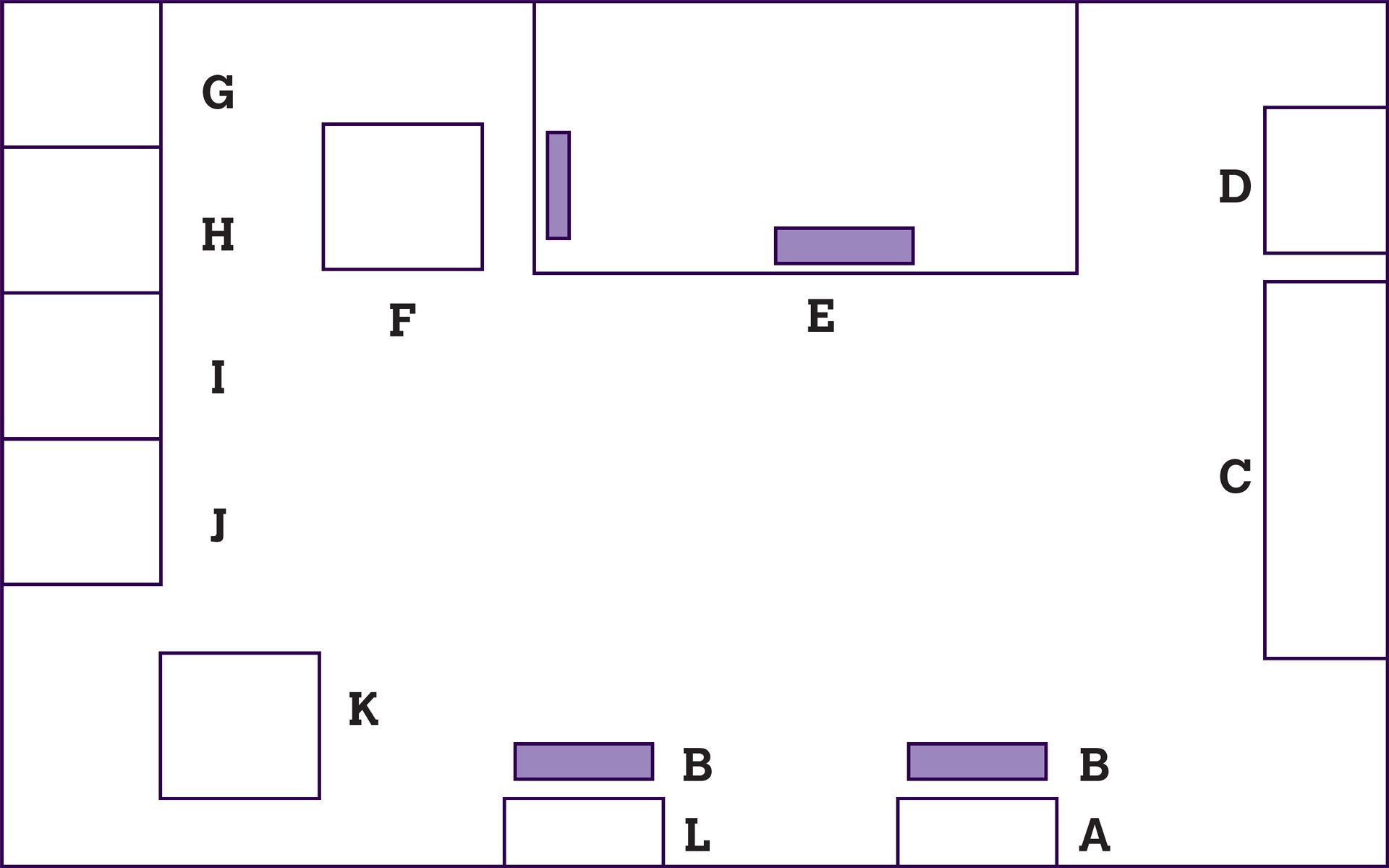
Figure 1. Maternity unit design. A: entrance; B: footbaths at entry and exit; C: food/medication preparation area, equipment storage and sink; D: PPE storage unit; E: maternity unit (incl. charts); F: decontamination zone; G: bins; H: dishwasher; I: washing machine; J: tumble dryer; K: handwash and sanitiser station; L: exit. Anticlockwise walking direction to reduce risk of cross-contamination and inter-person contact.
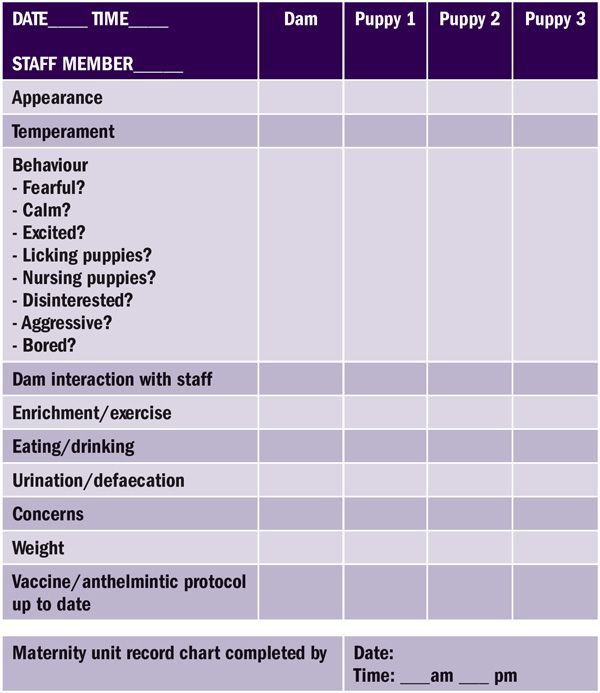
Figure 2: Maternity unit record chart.
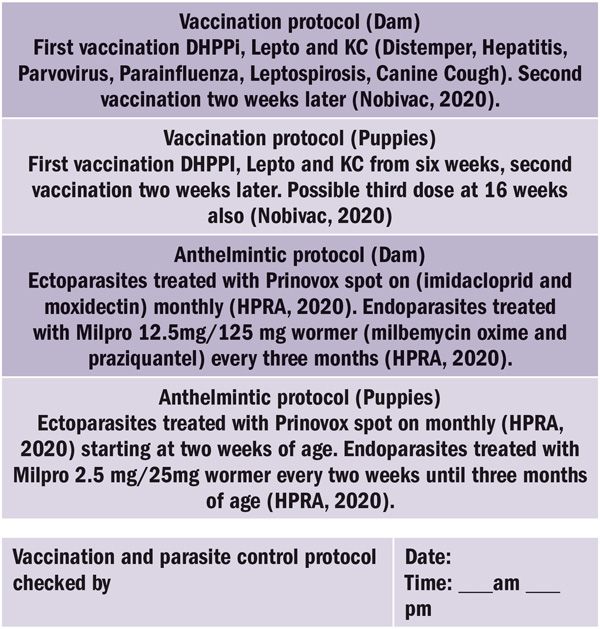
Figure 3. Vaccination and parasite control protocol. NB: Weigh puppies accurately to ensure correct anthelmintic dose. Check against data sheet.
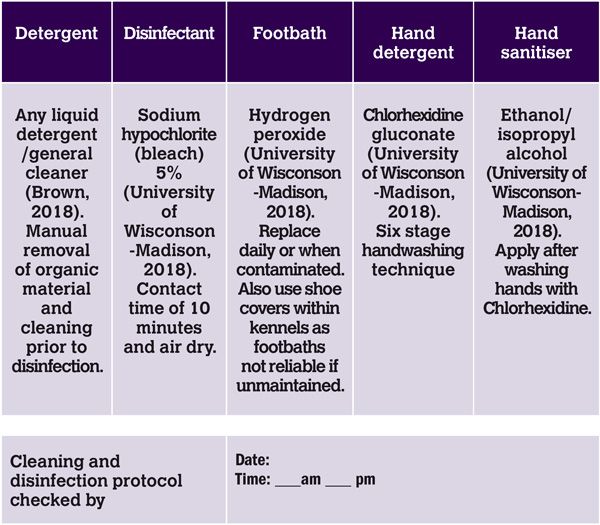
Figure 4. Cleaning and disinfection protocol.
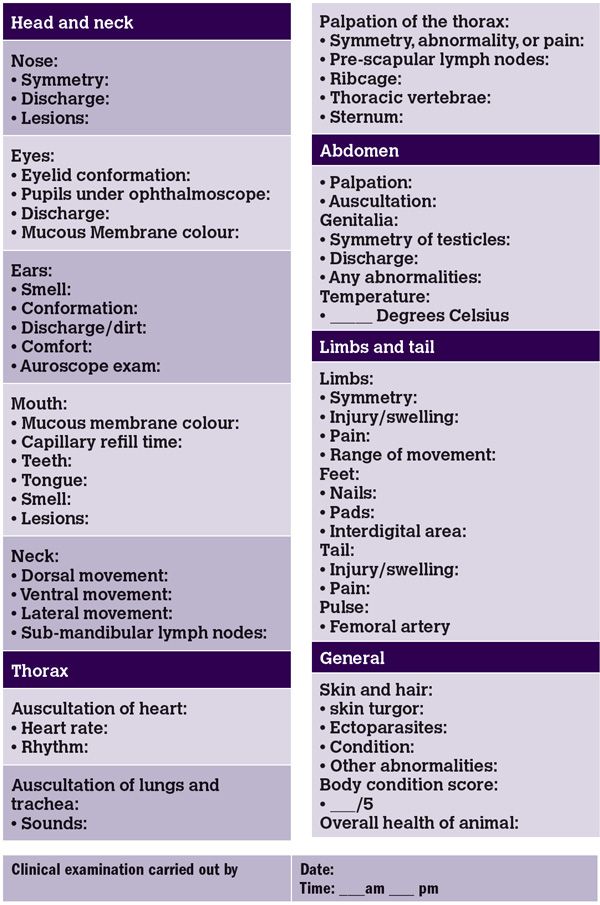
Figure 5. Clinical examination checklist.
-
Amaya, V., Paterson, M. B. & Phillips, C. J., 2020. Effects of Olfactory and Auditory Enrichment on the Behaviour of Shelter Dogs. Animals, 10(4), p. 581.
-
Boyden, P. & Morrow, L., 2018. Shelter design and flow of animals through a shelter. In: R. Dean, M. Roberts & J. Stavisky, eds. BSAVA Manual of Canine and Feline Shelter Medicine : Principles of Health and Welfare in a Multi-animal Environment. Quedgeley, Gloucester: BSAVA, p. 133.
-
Brown, J., 2018. Disinfection protocols - a clean start. [Online] Available at: https://www.veterinarypracticenews.com/disinfection-protocols-a-clean-start/ [Accessed 11 December 2020].
-
Gov.ie, 2020. COVID-19 (Coronavirus): Stay Safe Guidelines. [Online]
-
Available at: https://www.gov.ie/en/collection/428743-covid-19-coronavirus-physical-distancing-graphics/
[Accessed 14 December 2020].
-
Guardini, G. et al., 2016. Influence of morning maternal care on the behavioural responses of. Applied Animal Behaviour Science, Volume 181, pp. 137-144.
-
Gunter, L. M., Feuerbacher, E. N., Gilchrist, R. J. & Wynne, C. D., 2019. Evaluating the effects of a temporary fostering program on shelter dog welfare. Peer J, 7(e6620).
-
Hennessy, M. B., Willen, R. M. & Schiml, P. A., 2020. Psychological Stress, Its Reduction, and Long-Term Consequences: What Studies with Laboratory Animals Might Teach Us about Life in the Dog Shelter. MDPI, 10(2061).
-
HPRA, 2020. Milpro 12.5 mg/125 mg film-coated tablets for dogs. [Online]
Available at: http://www.hpra.ie/homepage/veterinary/veterinary-medicines-information/find-a-medicine/item?pano=VPA10988/095/002&t=Milpro%2012.5%20mg/125%20mg%20film-coated%20tablets%20for%20dogs
[Accessed 11 December 2020].
-
HPRA, 2020. Milpro 2.5 mg/25 mg film-coated tablets for small dogs and puppies. [Online]
Available at: http://www.hpra.ie/homepage/veterinary/veterinary-medicines-information/find-a-medicine/item?pano=VPA10988/095/001&t=Milpro%202.5%20mg/25%20mg%20film-coated%20tablets%20for%20small%20dogs%20and%20puppies
[Accessed 11 December 2020].
-
HPRA, 2020. Prinovox 40 mg + 10 mg spot-on solution for small dogs. [Online]
Available at: http://www.hpra.ie/homepage/veterinary/veterinary-medicines-information/find-a-medicine/item?pano=VPA22020/057/001&t=Prinovox%2040%20mg%20+%2010%20mg%20spot-on%20solution%20for%20small%20dogs
[Accessed 11 December 2020].
-
HSE, 2020. How to clean your hands. [Online]
Available at: https://www2.hse.ie/wellbeing/how-to-wash-your-hands.html
[Accessed 14 December 2020].
-
Irish Statute Book, 2013. Animal Health and Welfare Act 2013. [Online]
Available at: http://www.irishstatutebook.ie/eli/2013/act/15/enacted/en/print#sec11
[Accessed 09 December 2020].
-
ISPCA, 2020. About Us. [Online]
Available at: https://www.ispca.ie/who_we_are/
[Accessed 6 December 2020].
-
Lezama-García, K. et al., 2019. Maternal behaviour in domestic dogs. International Journal of Veterinary Science and Medicine, 7(1), pp. 20-30.
-
Morley, P. S., Morris, N. S. & Hyatt, , D. . R., 2005. Evaluation of the efficacy of disinfectant footbaths as used in veterinary hospitals. Pub Med, 226(12), pp. 2053-2058.
-
Newbury, E. & Miller, L., 2018. Biosecurity in shelters. In: R. Dean, M. Roberts & J. Stavisky, eds. BSAVA Manual of Canine and Feline Shelter Medicine : Principles of Health and Welfare in a Multi-animal Environment. Quedgeley, Gloucester: BSAVA, pp. 112-125.
-
Nobivac, 2020. Frequently asked questions. [Online]
Available at: http://www.vaccination.ie/FAQPetVaccines.aspx
[Accessed 10 December 2020].
-
Ogi, A. et al., 2020. Effects of Stroking on Salivary Oxytocin and Cortisol. MDPI, 10(708). University of Wisconson-Madison, 2018. Sanitation in Animal Shelters. [Online] Available at: https://www.uwsheltermedicine.com/library/resources/sanitation-in-animal-shelters#Foot%20sani
[Accessed 11 December 2020].
-
World Health Organisation, 2020. How to dilute and use bleach. [Online]
Available at: https://www.who.int/docs/default-source/wpro---documents/wpro---pdf-infographics/covid-19/bleach-dilution-and-guidance-for-visitors-20200622.pdf?sfvrsn=4fcf7133_2
[Accessed 11 December 2020].















